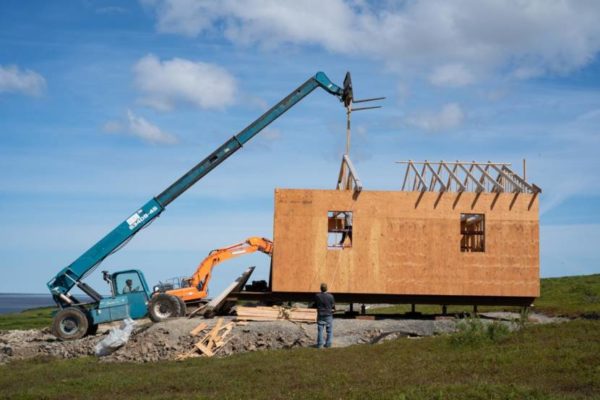
Lumber prices have soared across the country as demand for wood during the pandemic outstripped supply. In the Yukon-Kuskokwim Delta, those high prices have been slowing down construction of new homes, exacerbating a severe shortage of housing in the region.
According to the Alaska Housing Finance Corporation, about 40% of the homes in the Yukon-Kuskokwim Delta are overcrowded, 12 times more than the national average. The demand for new homes in the region is estimated to be well over 1,000 units.
Efforts to address that shortage, which were already insufficient, have slowed even more due to increases in lumber price. Association of Village Council Presidents Regional Housing Authority CEO Mark Charlie said the organization usually receives enough federal funding to build 15 to 20 homes in the region annually. But that was before lumber costs to build a home shot up almost 40% in the past year, he said.
“We get the same amount of funding from the federal government. If the price of material for lumber and stuff go up, then that just means we build, you know, less homes,” Charlie said.
Orutsararmiut Native Council is facing the same problem, as the tribe builds a new subdivision to address Bethel’s housing shortage. ONC Housing Director Calvin Cockroft said building costs are 80% higher than in previous years for materials, including commodities besides lumber such as sheet metal. And Cockroft said his suppliers are advising him to put in orders sooner rather than later.
“What the supplier did say was that, you know, if we don’t get the order really soon, that the prices are going to go up again,” Cockroft said.
Luckily, both organizations are able to offset some of the increased costs with federal CARES Act and American Rescue Plan Act funding.
Cockroft said ONC plans to continue construction of the new subdivision as scheduled, despite increased costs. ONC will start building four homes this summer in the new Bethel subdivision, and expect to complete them early next summer.
In the case of the AVCP housing authority, federal stimulus funding allowed the regional housing authority to build even more houses than it normally would.
“Because we got extra money, the CARES Act funding that we got, we’re adding units to villages that are facing imminent danger of losing their homes due to environmental threats like erosions or sinkholes,” Charlie said.
Charlie said CARES Act funding would allow AVCP Housing to start building six extra homes this year in Newtok and one or two in Akiak, Kotlik, and Chefornak. All four of those communities are facing environmental threats worsened by climate change.
But lumber price hikes are hammering private businesses that didn’t receive funding from the CARES Act or ARPA. Brian Glasheen is the co-owner of AMW Construction, which builds and manages rental properties in Bethel. He said lumber price increases dramatically changed his company’s plans.
“We had a very aggressive schedule for this summer. We picked up a couple new pieces of property and wanted to build a few more rentals. However, because of the lumber prices, we have decided not to,” Glasheen said.
Another part of Glasheen’s business is building new houses. Glasheen said some customers have had to back out due to material costs, which has left his company with little work to do.
“We likely will have to lay off some of our crew, for sure, in the wintertime, as we may not have enough work to keep everyone busy throughout the winter,” he said.
Glasheen said AMW is getting creative, taking on construction projects outside Bethel, something they don’t normally do.
Most of the lumber sold in the Yukon-Kuskokwim Delta is imported. But lumber is also produced and sold within the area. Prices for locally produced lumber aren’t increasing due to national market trends, but they’re still rising for another reason.
Mark Leary, operations director for the Native Village of Napaimute, oversees a 400-acre timber lot and sawmill operation a few miles downstream of Kalskag which produces lumber for homes and cabins in the Y-K Delta.
“For our little operation, it’s all those wildfires thousands of miles away from us,” Leary said.
Leary said because of record-setting wildfires in California and other parts of the United States in 2020, insurance agencies have been reluctant to offer wildfire insurance to lumber companies.
“We just recently found one and, of course, it’s quadruple what we usually pay,” Leary said.
He said those higher insurance costs will have to be passed on to buyers.
In a region geographically isolated from the rest of the country, soaring lumber prices are a reminder that what happens elsewhere in the country still ends up affecting the Yukon-Kuskokwim Delta.




